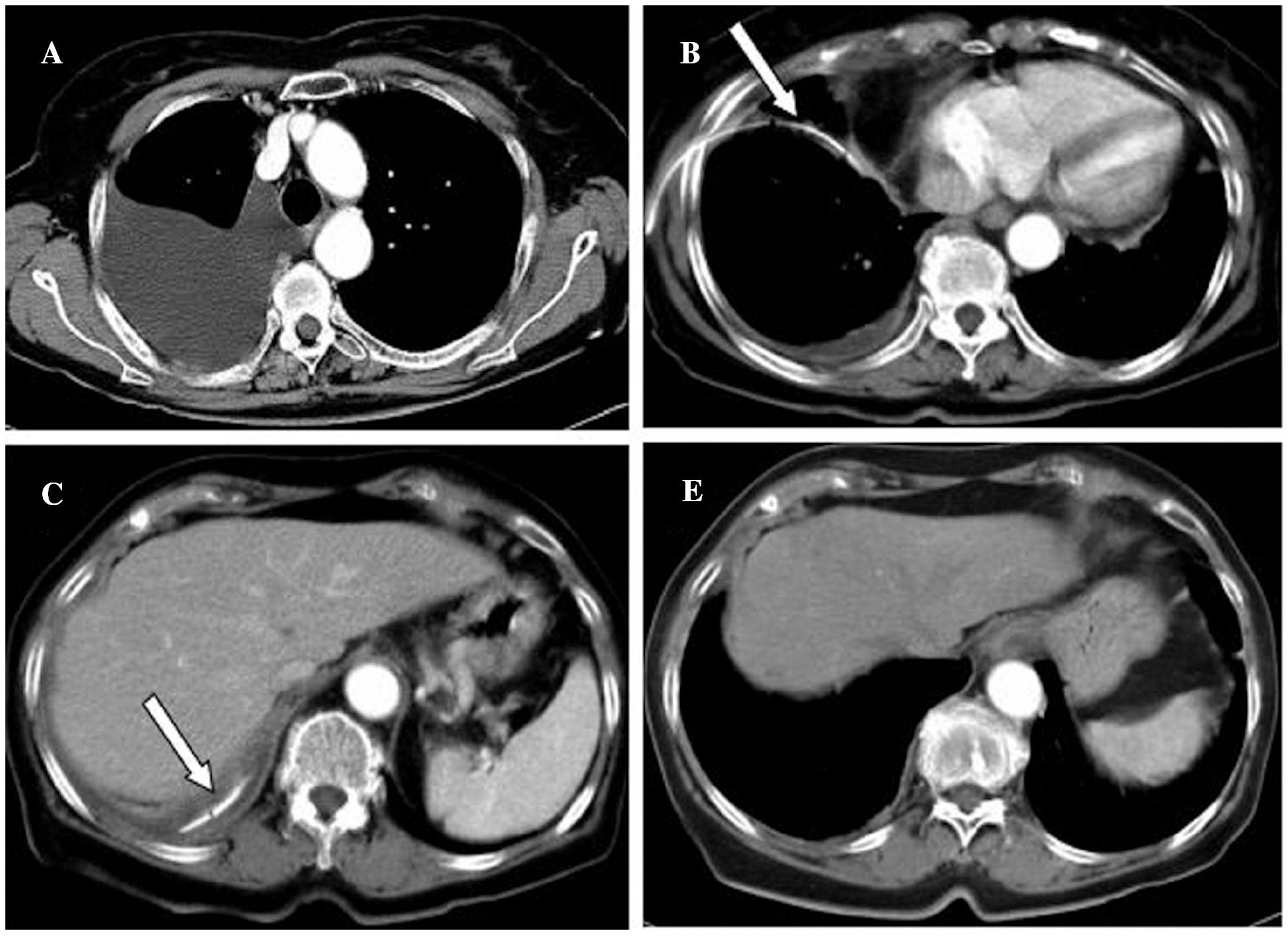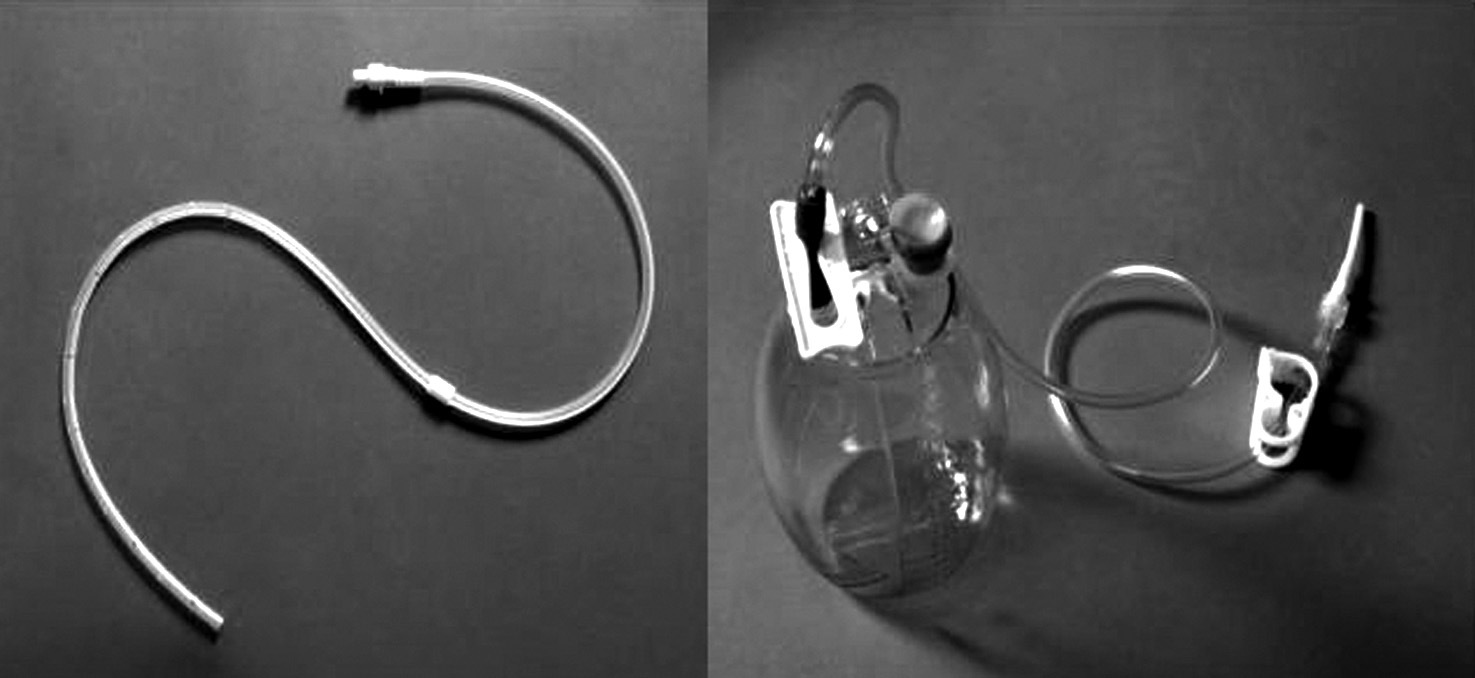Introducción
El derrame pleural maligno es una complicación temida de muchas neoplasias, ya que, además de implicar un mal pronóstico, con frecuencia se acompaña de síntomas como tos, dolor torácico o disnea, que merman la calidad de vida del paciente. La tercera parte de los derrames pleurales malignos son de origen broncogénico, seguidos de cáncer de mama, linfoma y, menos frecuentemente, el mesotelioma pleural maligno y otros1-3. En general, la supervivencia media de estos pacientes no supera los 6 meses4. Por consiguiente, el manejo del derrame pleural maligno condiciona un enfoque predominantemente paliativo, que alivie el dolor y permita el control de los síntomas de la manera menos agresiva y más eficaz posible, limitando el tiempo que el paciente debe permanecer ingresado.
Hay varias técnicas disponibles para el manejo del derrame pleural maligno. La toracocentesis de repetición, aunque fácil de realizar y generalmente exenta de complicaciones, no es la solución ideal, ya que en muchos casos la reacumulación de líquido tiene lugar en un espacio de tiempo muy corto (hasta 4 días)5. Por este motivo, la solución habitual estriba en recurrir a la toracostomía convencional, seguida de esclerosis mediante talcaje, o incluso en algunos casos la videotoracoscopia. Ambas opciones terapéuticas, aunque muy eficaces, no están exentas de morbilidad y requieren por lo general un ingreso hospitalario, que en algunos casos puede llegar a superar los 10 días.
El desarrollo de diversos catéteres pleurales de pequeño calibre abre la puerta a nuevas estrategias para el tratamiento del derrame pleural maligno con un mínimo de morbilidad asociada, y permite en algunos casos el manejo de forma amulatoria6-9. Diversos estudios han demostrado la eficacia paliativa de estos catéteres, que se asocian con un bajo coste, una reducción de la estancia hospitalaria y menos dolor10-12.
Observación clínica
Presentamos el caso de una paciente de 77 años de edad, no fumadora, diagnosticada de adenocarcinoma de pulmón en estadio IIIB, con derrame pleural maligno. A pesar de que inicialmente respondió al tratamiento con Tarceva®, a partir de febrero de 2005 se objetivó la reacumulación del líquido pleural (fig. 1A). El derrame se asociaba a disnea, que progresó hasta hacerse de mínimos esfuerzos, y tos irritativa sin expectoración. En la exploración física destacaban saturación basal del 95% y matidez a la percusión en la base derecha, con pérdida del murmullo vesicular fisiológico en gran parte de ese hemitórax. En la placa de tórax de abril se objetivó un derrame pleural derecho importante, motivo por el que se optó por colocar un tubo de drenaje Pleurx® (Denver Biomedical) (figs. 1B y C). La colocación del drenaje se realizó sin incidencias, tras obtener el consentimiento informado correspondiente, bajo sedación (2,5 mg de midazolam) y con anestesia local. Se drenaron 1.100 ml de líquido serohemático y se educó a un familiar de la paciente en su correcto manejo en condiciones de asepsia, con el propósito de drenar líquido pleural de forma ambulatoria cada 2-3 días. La paciente toleró el catéter sin apenas notar su presencia y sin disnea en las semanas siguientes a su colocación, si bien refería dolor torácico de escasa intensidad, que cedía con el tratamiento analgésico pautado. Una vez que la cantidad de líquido extraído se redujo a menos de 50 ml en 3 ocasiones consecutivas, se optó por retirar el catéter tras comprobar la ausencia de derrame mediante tomografía axial computerizada de tórax un mes después de su colocación.
Fig. 1. En la exploración de abril se objetiva la presencia de un cuantioso derrame pleural derecho (A). En la citología se confirma la presencia de células tumorales. En la exploración de mayo (B y C) ha disminuido la cantidad de líquido. Las flechas señalan la localización del drenaje pleural. Dos meses después de la retirada del catéter (D) se confirma que no hay reacumulación de líquido pleural. No fue preciso realizar talcaje.
Se realizó una nueva tomografía axial computarizada de tórax a los 2 meses de retirar el Pleurx® (fig. 1D). En dicho escáner tan sólo se evidenció la presencia de engrosamiento pleural residual, sin reacumulación de líquido. La paciente falleció a los pocos meses por motivos ajenos a su enfermedad respiratoria, sin evidencia de reacumulación de líquido y sin disnea.
Discusión
El catéter Pleurx®, como otros similares, ofrece la posibilidad de manejar de forma fiable y sin ingreso hospitalario cualquier derrame pleural maligno (fig. 2). La mayor ventaja de este catéter es su tunelización, circunstancia que permite al paciente llevar una vida normal con un mínimo riesgo de infección. La colocación de este drenaje requiere apenas 20 min y permite drenar líquido pleural a demanda de forma ambulatoria. En los diversos estudios publicados, se describen como efectos secundarios adversos la ocasional aparición de infecciones cutáneas superficiales, que se limitan al lugar de inserción, dolor torácico leve y, de manera excepcional, crecimiento del tumor a lo largo del trayecto de tunelización. Describimos en esta breve nota clínica nuestra experiencia con el primer catéter Pleurx® colocado en nuestro país. Como se ha demostrado en otras publicaciones, las complicaciones asociadas a la colocación y el manejo de este catéter son mínimas, y hasta en un 58% de los casos no es necesario realizar esclerosis farmacológica, ya que ésta se consigue de forma espontánea en una media de 39 días13. La colocación, el manejo y la retirada posterior del catéter se realizan de forma ambulatoria. El Pleurx® logra aliviar los síntomas de disnea asociados al derrame pleural maligno en la totalidad de los pacientes, independientemente de si se consigue la esclerosis o no13. Además de una mejor tolerancia, está claro que el coste asociado es mucho menor al de las opciones terapéuticas convencionales, que requieren ingreso hospitalario (3.391 frente a 7.830 dólares)14. En la actualidad hay un estudio clínico en fase III, patrocinado por el instituto nacional del cáncer norteamericano (NCT00042770), que se ha diseñado para comparar la eficacia de la toracostomía convencional con el manejo ambulatorio del derrame pleural maligno mediante colocación de catéteres tunelizados; en él se analiza el impacto de cada estrategia terapéutica sobre la calidad de vida de los pacientes, su oxigenación y el control o erradicación del derrame pleural a corto y medio plazo13.
Fig. 2. El catéter tunelizado Pleurx® y una botella para drenaje ambulatorio.
Correspondencia: Dr. L. Seijo.
Departamento de Neumología. Clínica Universitaria de Navarra.
Avda. Pío XII, 36. 31008 Pamplona. Navarra. España.
Correo electrónico: lmseijo@unav.es
Recibido: 7-2-2006; aceptado para su publicación: 14-2-2006.













